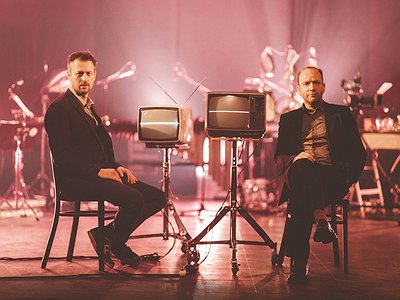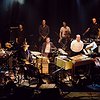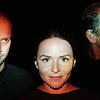Name: The Colorist Orchestra
Main members: Aarich Jespers, Kobe Proesmans
Occupation: Composers, arrangers, songwriters, drummers, percussionists
Nationality: Belgian
Current release: The Colorist Orchestra's collaboration with Howe Gelb, Not on the Map, is out via Dangerbird Records / Membran. [Read our Howe Gelb interview]
Recommendations: Aarich: The work of Bruno Munari and the work of Tibor Kalman // Kobe: I loved the book ' Walden' by Henry David Thoreau and would recommend; just go out there.
If you enjoyed this interview with The Colorist Orchestra and would like to find out more about their work, visit the official Colorist Orchestra homepage. You can also find the duo on Instagram, Facebook, and Soundcloud.
When did you start writing/producing music - and what or who were your early passions and influences? What was it about music and/or sound that drew you to it?
Aarich: The house where I grew up was always filled with the music my parents would play from their record player. A mix of genres - Bob Dylan, Memphis Slim, John Lee Hooker, Thelonious Monk, Marianne Faithfull, Ray Charles, Etnic music, Talking Heads … so at an early age I was interested in music.
I started to play the violin and piano, but it wasn't until after I joined a band with some school friends that I started to play the drums. The music we played was inspired by Tom Waits, Captain Beefhaert, and Moondog. At that time there where many bands in Antwerp (Belgium) that formed a kind of collective (dEUS, Dead Man Ray, Kiss My Jazz, Evil Superstars, Moondog Jr., Zita Swoon, DAAU) and in many cases, musicians would hop from one band to another. It was very inspiring to have all these different musical relationships with one another.
The main bands I was in (Moondog Jr., Zita Swoon) were all people from art school, and initially the playing was very limited and primitive. We actually learned our instruments on stage. With our background in art school we would participate in many projects that were off the beaten track of ‘a rock group’ - soundtracks for movies or theatre, dance, exhibitions … which were all an excuse to focus on instrumental and more experimental music.
And now we compose and arrange music as we learned by doing all of this. The research in sound and production is a mix of pop music and avant-garde where we try to avoid a typical setup with bass/guitar/piano/drums. The self made instruments, objects, and classical instruments are the basic elements for the music we’re writing.
Kobe: I grew up with traditional folk music. While my father spent hours playing one melody after another on his accordion or piano, I scratched along on the violin from a very young age. Improvisation was more a form of keeping up while learning the melody by ear, while playing. Making melodies, thinking up grooves was natural in a house where music was a big part of communication.
Making music was a way to feel connected. It started with classical folk tunes from Ireland, Sweden, Belgium, France, Germany, etc. but around my teenage years I discovered the universe of World Music as well as the love for rhythm and grooves. Gradually the world of percussion took over and I came into contact with a new inexhaustible vocabulary, a never ending story.
Thanks to my mother, dancing has always been a very big motivation for making music. Making people dance through music is wonderful! Whether something resonates physically is still a reference point in my work today.
For most artists, originality is preceded by a phase of learning and, often, emulating others. What was this like for you: How would you describe your own development as an artist and the transition towards your own voice?
Aarich: Banging on cardboard boxes, metal and wood was how I started to play the drums. It was unique and original, but the choice was made because I had no real drum kit. By discovering the music of Einstürzende Neubauten, Bongo Joe, Harry Partch, we found that it was really cool to use objects as musical instruments instead of real instruments.
Playing percussion in layered multiple parts (like you would hear in African or Latin American music), was another thing that Kobe and I would develop. I’m not a musician that is capable of doing stuff other than what I’m doing, I’m very limited in what I can do, so in this sense I don’t know if I am a real musician. But I’m happy that this led to my own voice.
Kobe: It has always fascinated me how I could translate something I learned from others into a more personal form. During my studies I was mainly confronted with what I couldn't do and yet it was also the driving force not to give up. Turning a limitation into an added value has long been a necessity in my school career.
Now, after all these years, I know that this was the ideal breeding ground for daring to think differently, and the necessary weird ideas for a self-willed artistic path.
How do you feel your sense of identity influences your creativity?
Aarich: This is an obvious result of having your own voice. My identity has an influence on everything I do. There’s another component influencing the work of The Colorist Orchestra by working as a duo, in many cases the outcome is a mix of two identities.
The choice of working with the same Orchestra for a long time has also influenced the character of our compositions, each instrument and musician is integrated in our writing.
Kobe: My identity is my artistic pamphlet especially when I play. When I feel strong I play strong, when I feel confused I play from an uncertain role.
Similarly, the synergy between Aarich and myself is unique. We are very different, yet very complementary. It is therefore crucial for me in an artistic process to feel comfortable with the people with whom I create. At TCO, each person involved is a not-to-be-missed piece of the puzzle. If all the puzzle pieces are in the sun, then the whole can actually reflect the sunlight.
What were your main creative challenges in the beginning and how have they changed over time?
Aarich: In the beginning we would try to reconstruct the work of others or write music that is very much inspired by artists we loved. Over the years we've carried a bag full of inspirations that would help us come up with new music. And it’s not always clear where we found all these inspirations.
It’s not only music; a piece of art, a book, architecture or a landscape can be the inspiration for whatever we are making. Over time we’ve seen and heard so many things that there’s a richness, a melting pot that influences our music.
Interviews / About
Fifteen Questions Interview with The Colorist Orchestra
Reality in the Distance
Part 1

Kobe: "The synergy between Aarich and myself is unique. We are very different, yet very complementary. At TCO, each person involved is a not-to-be-missed piece of the puzzle. If all the puzzle pieces are in the sun, then the whole can reflect the sunlight."



